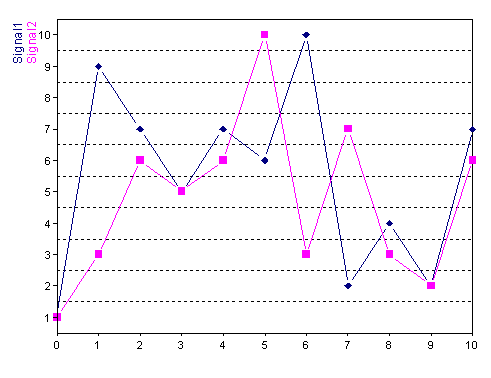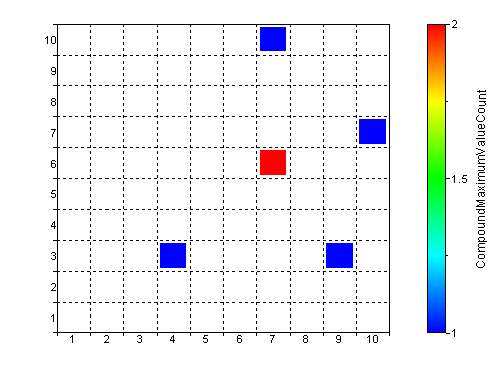CompoundMaximumValueCount (FPScript)
Performs a maximum value count in accordance with the DIN 45667 standard synchronously for two signals.
Syntax
CompoundMaximumValueCount(Signal1, Signal2, ClassLimits1, ClassLimits2, [ ReductionFactor = 1 ] [ , Normalize = 0 ])
The syntax of the CompoundMaximumValueCount function consists of the following parts:
Part |
Description |
|---|---|
Signal1 |
The first signal to be examined. Permitted data structures are data series und signal. All real data types are permitted. If the argument is a list, then the function is executed for each element of the list and the result is also a list. |
Signal2 |
The second signal to be examined. Permitted data structures are data series und signal. All real data types are permitted. If the argument is a list, then the function is executed for each element of the list and the result is also a list. |
ClassLimits1 |
Contains a data series, which contains the class limits for the first signal. If ClassLimits1 contains n values, this leads to n-1 closed classes. The first or the last value in ClassLimits1 provides the lowest or highest limit of the class division. Values that lie outside the limits are not counted. Permitted data structures are data series. All real data types are permitted. The unit has to be compatible with that of parameter Signal1. If the argument is a list, then the first element in the list is taken. If this is also a list, then the process is repeated. |
ClassLimits2 |
Contains a data series, which contains the class limits for the second signal. Permitted data structures are data series. All real data types are permitted. The unit has to be compatible with that of parameter Signal2. If the argument is a list, then the first element in the list is taken. If this is also a list, then the process is repeated. |
ReductionFactor |
Specifies a reduction factor. Only the highest of ReductionFactor values in each case is counted from the data set. For a reduction factor greater than one, you could lose information, since not all measurement values are counted. Permitted data structures are scalar value. All integral data types are permitted. If the argument is a list, then the first element in the list is taken. If this is also a list, then the process is repeated. If this argument is omitted, it will be set to the default value 1. |
Normalize |
Specifies a value to which the frequencies are to be normalized. If you specify 0 here, no normalization occurs, and the function provides the absolute frequencies. Permitted data structures are scalar value. All real data types are permitted. If the argument is a list, then the first element in the list is taken. If this is also a list, then the process is repeated. If this argument is omitted, it will be set to the default value 0. |
Remarks
Void values are not counted. The result is a signal series with a Z component with the absolute or normalized frequencies in the Y component. The X component or Z component then contains the mid-points of the class divisions specified as the arguments ClassLimits1 or ClassLimits2 respectively.
Absolute frequencies are returned as 64-bit integers and normalized frequencies as floating point values.
Available in
Option Counting Procedures
Examples
CompoundMaximumValueCount(Signal1, Signal2, (11., 0.5, 1), (11., 0.5, 1), 2)
Performs a maximum value count for the two signals 'Signal1' and 'Signal2'. The maxima from two values per signal are searched for and then counted. The result are absolute frequencies with 10 classes for both signals.


CompoundMaximumValueCount(Signal1, Signal2, (11., 0.5, 1), (11., 0.5, 1), 2, 100 %)
Carries out a maximum value count and normalizes the frequencies to 100 %.
See Also
CompoundSamplingCount Function
